Significance of ASIC and TPB Funding Issue in Accounting Industry
VerifiedAdded on 2023/02/01
|16
|4042
|32
AI Summary
This article discusses the significance of ASIC (Australia Securities and Investments Commission) and the funding issue of TPB (Tax Practitioners Board) in the accounting industry. It highlights the responsibilities of ASIC and the underfunding of regulators in the industry. It also explores the need for funding for TPB and the impact of underfunding on the accounting industry. The article concludes by emphasizing the importance of resolving the funding issue to enhance business operations in the accounting industry.
Contribute Materials
Your contribution can guide someone’s learning journey. Share your
documents today.
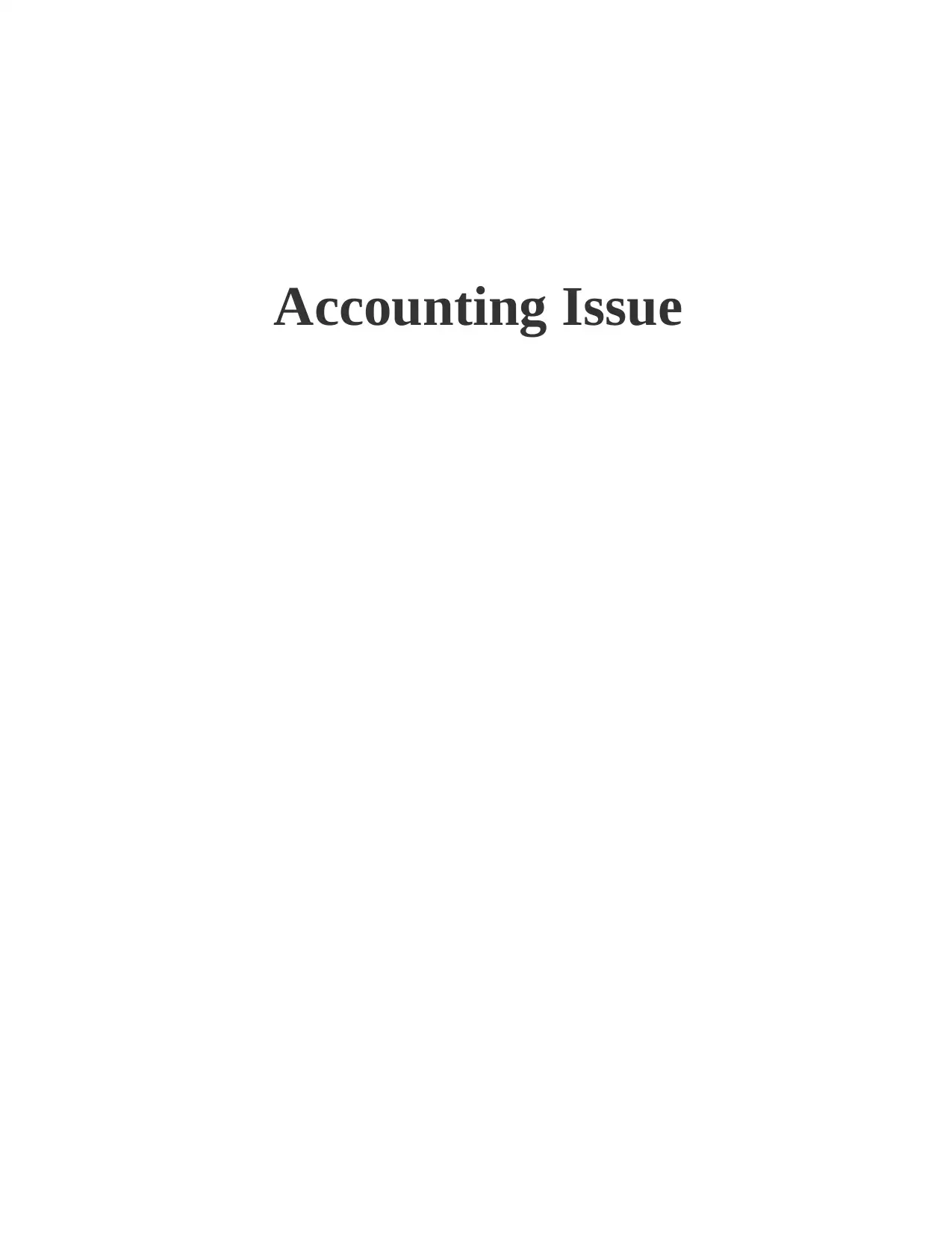
Accounting Issue
Secure Best Marks with AI Grader
Need help grading? Try our AI Grader for instant feedback on your assignments.
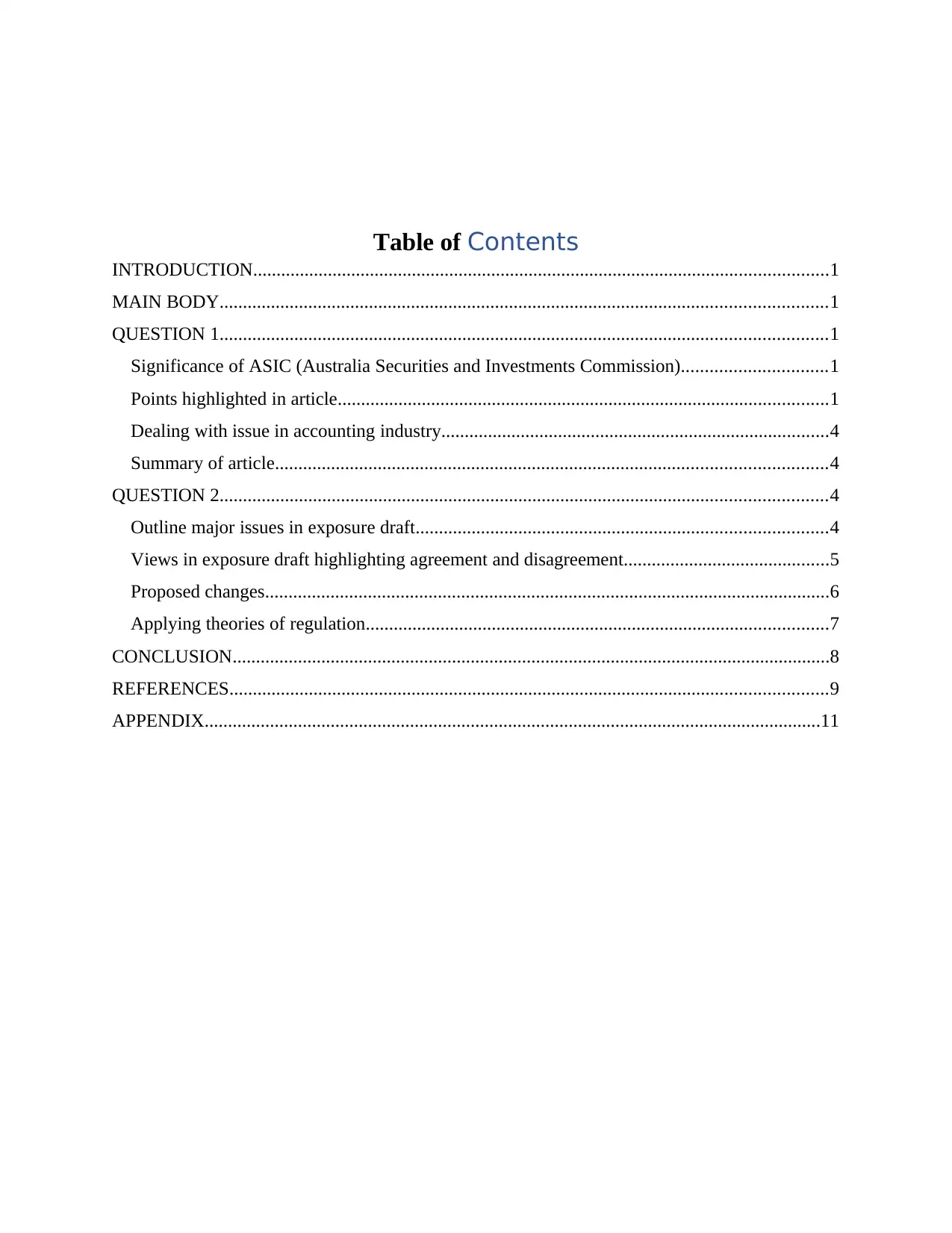
Table of Contents
INTRODUCTION...........................................................................................................................1
MAIN BODY..................................................................................................................................1
QUESTION 1..................................................................................................................................1
Significance of ASIC (Australia Securities and Investments Commission)...............................1
Points highlighted in article.........................................................................................................1
Dealing with issue in accounting industry...................................................................................4
Summary of article......................................................................................................................4
QUESTION 2..................................................................................................................................4
Outline major issues in exposure draft........................................................................................4
Views in exposure draft highlighting agreement and disagreement............................................5
Proposed changes.........................................................................................................................6
Applying theories of regulation...................................................................................................7
CONCLUSION................................................................................................................................8
REFERENCES................................................................................................................................9
APPENDIX....................................................................................................................................11
INTRODUCTION...........................................................................................................................1
MAIN BODY..................................................................................................................................1
QUESTION 1..................................................................................................................................1
Significance of ASIC (Australia Securities and Investments Commission)...............................1
Points highlighted in article.........................................................................................................1
Dealing with issue in accounting industry...................................................................................4
Summary of article......................................................................................................................4
QUESTION 2..................................................................................................................................4
Outline major issues in exposure draft........................................................................................4
Views in exposure draft highlighting agreement and disagreement............................................5
Proposed changes.........................................................................................................................6
Applying theories of regulation...................................................................................................7
CONCLUSION................................................................................................................................8
REFERENCES................................................................................................................................9
APPENDIX....................................................................................................................................11

INTRODUCTION
The accounting is an art of recording, classifying, interpreting and summarising information
for providing useful insights about business performance. Present report deals with two questions
in which first one is dedicated to recent news article published on professional journal. The
ideas, concepts and core issue of accounting field are discussed. The issue is related to TPB
funding issue from ATO. On the other hand, next question deals with exposure draft published
by FASB on “Revenue from Contracts with Customers-Recognising assumed liability” has been
used governing major issue proposed in the draft. Furthermore, proposed changes along with
benefits and cost related to topic have been disclosed and theories of regulation are being
discussed.
MAIN BODY
QUESTION 1
Significance of ASIC (Australia Securities and Investments Commission)
ASIC is Australian government independent body acting as a corporate regulator since 1
July, 1998. The major role of this body is to effectively enforce and regulate organisation and
financial service laws in effectual manner. The laws are meant to protect consumers, investors
and creditors of Australia forming the part of economy’s investment scenario in the best manner
possible. The responsibilities of ASIC include corporate governance, financial services,
insurance services, consumer protection (Butler, (2019). Furthermore, responsibilities such as
securities and derivatives and providing financial literacy to regulators are offered as well by the
body. The authority and scope of ASIC is determined by Australian Securities and Investments
Commission Act, 2001. The body reports to Treasurer and is responsible for administration of
legislations such as Corporations Act 2001, Insurance Contracts Act, 1984 and National
Consumer Credit Protection Act, 2009.
Points highlighted in article
Article’s link-
Lian. 2019 ‘Better now than never’: A regulatory funding lesson for the accounting industry
[Online] Available Through: <https://www.accountantsdaily.com.au/business/12614-better-now-
than-never-a-regulatory-funding-lesson-for-the-accounting-industry>.
The underfunding of regulators in the industry is contributing to stark findings of Royal
Commission with parallels to be drawn to regulation of accounting industry in accordance to
1
The accounting is an art of recording, classifying, interpreting and summarising information
for providing useful insights about business performance. Present report deals with two questions
in which first one is dedicated to recent news article published on professional journal. The
ideas, concepts and core issue of accounting field are discussed. The issue is related to TPB
funding issue from ATO. On the other hand, next question deals with exposure draft published
by FASB on “Revenue from Contracts with Customers-Recognising assumed liability” has been
used governing major issue proposed in the draft. Furthermore, proposed changes along with
benefits and cost related to topic have been disclosed and theories of regulation are being
discussed.
MAIN BODY
QUESTION 1
Significance of ASIC (Australia Securities and Investments Commission)
ASIC is Australian government independent body acting as a corporate regulator since 1
July, 1998. The major role of this body is to effectively enforce and regulate organisation and
financial service laws in effectual manner. The laws are meant to protect consumers, investors
and creditors of Australia forming the part of economy’s investment scenario in the best manner
possible. The responsibilities of ASIC include corporate governance, financial services,
insurance services, consumer protection (Butler, (2019). Furthermore, responsibilities such as
securities and derivatives and providing financial literacy to regulators are offered as well by the
body. The authority and scope of ASIC is determined by Australian Securities and Investments
Commission Act, 2001. The body reports to Treasurer and is responsible for administration of
legislations such as Corporations Act 2001, Insurance Contracts Act, 1984 and National
Consumer Credit Protection Act, 2009.
Points highlighted in article
Article’s link-
Lian. 2019 ‘Better now than never’: A regulatory funding lesson for the accounting industry
[Online] Available Through: <https://www.accountantsdaily.com.au/business/12614-better-now-
than-never-a-regulatory-funding-lesson-for-the-accounting-industry>.
The underfunding of regulators in the industry is contributing to stark findings of Royal
Commission with parallels to be drawn to regulation of accounting industry in accordance to
1
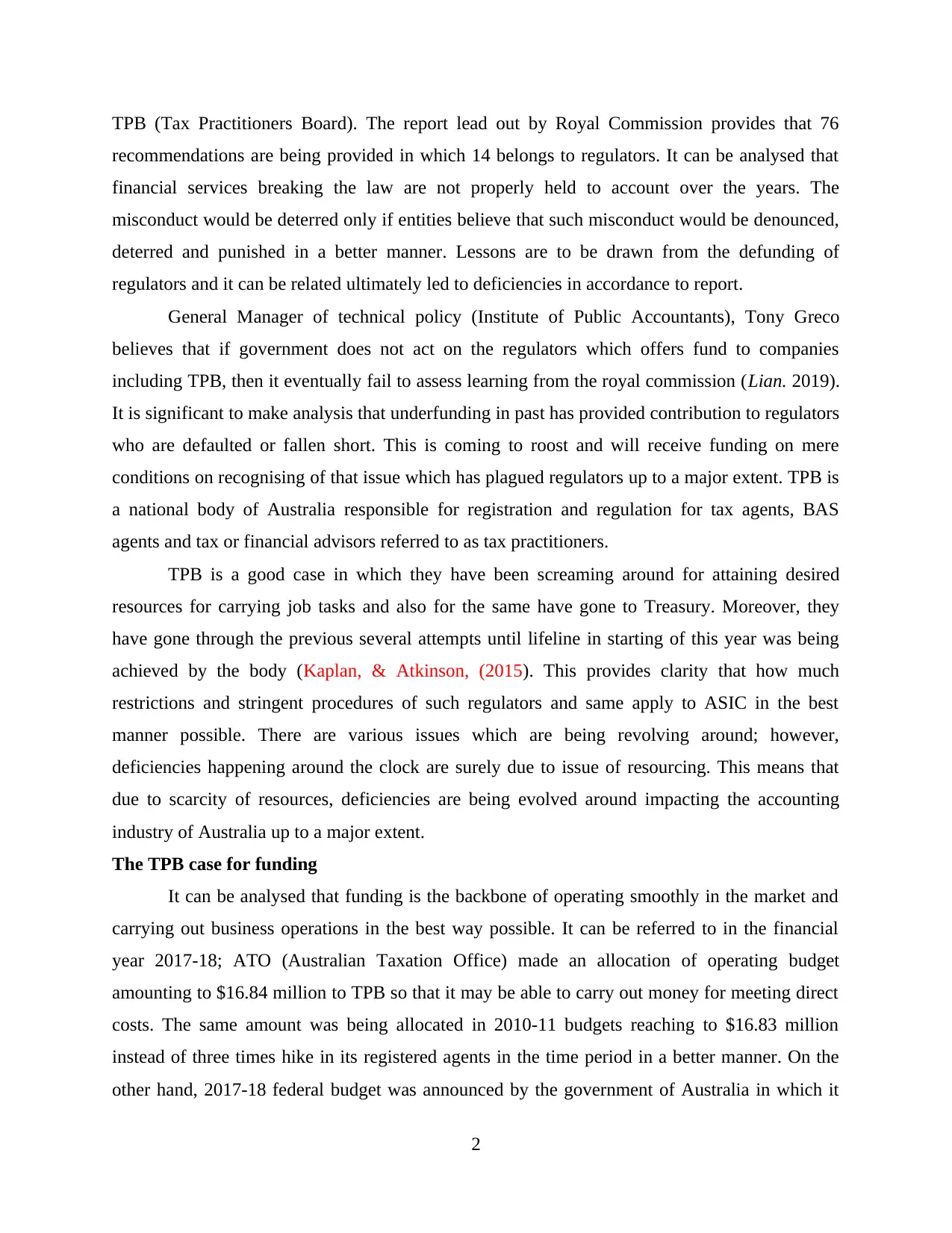
TPB (Tax Practitioners Board). The report lead out by Royal Commission provides that 76
recommendations are being provided in which 14 belongs to regulators. It can be analysed that
financial services breaking the law are not properly held to account over the years. The
misconduct would be deterred only if entities believe that such misconduct would be denounced,
deterred and punished in a better manner. Lessons are to be drawn from the defunding of
regulators and it can be related ultimately led to deficiencies in accordance to report.
General Manager of technical policy (Institute of Public Accountants), Tony Greco
believes that if government does not act on the regulators which offers fund to companies
including TPB, then it eventually fail to assess learning from the royal commission (Lian. 2019).
It is significant to make analysis that underfunding in past has provided contribution to regulators
who are defaulted or fallen short. This is coming to roost and will receive funding on mere
conditions on recognising of that issue which has plagued regulators up to a major extent. TPB is
a national body of Australia responsible for registration and regulation for tax agents, BAS
agents and tax or financial advisors referred to as tax practitioners.
TPB is a good case in which they have been screaming around for attaining desired
resources for carrying job tasks and also for the same have gone to Treasury. Moreover, they
have gone through the previous several attempts until lifeline in starting of this year was being
achieved by the body (Kaplan, & Atkinson, (2015). This provides clarity that how much
restrictions and stringent procedures of such regulators and same apply to ASIC in the best
manner possible. There are various issues which are being revolving around; however,
deficiencies happening around the clock are surely due to issue of resourcing. This means that
due to scarcity of resources, deficiencies are being evolved around impacting the accounting
industry of Australia up to a major extent.
The TPB case for funding
It can be analysed that funding is the backbone of operating smoothly in the market and
carrying out business operations in the best way possible. It can be referred to in the financial
year 2017-18; ATO (Australian Taxation Office) made an allocation of operating budget
amounting to $16.84 million to TPB so that it may be able to carry out money for meeting direct
costs. The same amount was being allocated in 2010-11 budgets reaching to $16.83 million
instead of three times hike in its registered agents in the time period in a better manner. On the
other hand, 2017-18 federal budget was announced by the government of Australia in which it
2
recommendations are being provided in which 14 belongs to regulators. It can be analysed that
financial services breaking the law are not properly held to account over the years. The
misconduct would be deterred only if entities believe that such misconduct would be denounced,
deterred and punished in a better manner. Lessons are to be drawn from the defunding of
regulators and it can be related ultimately led to deficiencies in accordance to report.
General Manager of technical policy (Institute of Public Accountants), Tony Greco
believes that if government does not act on the regulators which offers fund to companies
including TPB, then it eventually fail to assess learning from the royal commission (Lian. 2019).
It is significant to make analysis that underfunding in past has provided contribution to regulators
who are defaulted or fallen short. This is coming to roost and will receive funding on mere
conditions on recognising of that issue which has plagued regulators up to a major extent. TPB is
a national body of Australia responsible for registration and regulation for tax agents, BAS
agents and tax or financial advisors referred to as tax practitioners.
TPB is a good case in which they have been screaming around for attaining desired
resources for carrying job tasks and also for the same have gone to Treasury. Moreover, they
have gone through the previous several attempts until lifeline in starting of this year was being
achieved by the body (Kaplan, & Atkinson, (2015). This provides clarity that how much
restrictions and stringent procedures of such regulators and same apply to ASIC in the best
manner possible. There are various issues which are being revolving around; however,
deficiencies happening around the clock are surely due to issue of resourcing. This means that
due to scarcity of resources, deficiencies are being evolved around impacting the accounting
industry of Australia up to a major extent.
The TPB case for funding
It can be analysed that funding is the backbone of operating smoothly in the market and
carrying out business operations in the best way possible. It can be referred to in the financial
year 2017-18; ATO (Australian Taxation Office) made an allocation of operating budget
amounting to $16.84 million to TPB so that it may be able to carry out money for meeting direct
costs. The same amount was being allocated in 2010-11 budgets reaching to $16.83 million
instead of three times hike in its registered agents in the time period in a better manner. On the
other hand, 2017-18 federal budget was announced by the government of Australia in which it
2
Secure Best Marks with AI Grader
Need help grading? Try our AI Grader for instant feedback on your assignments.
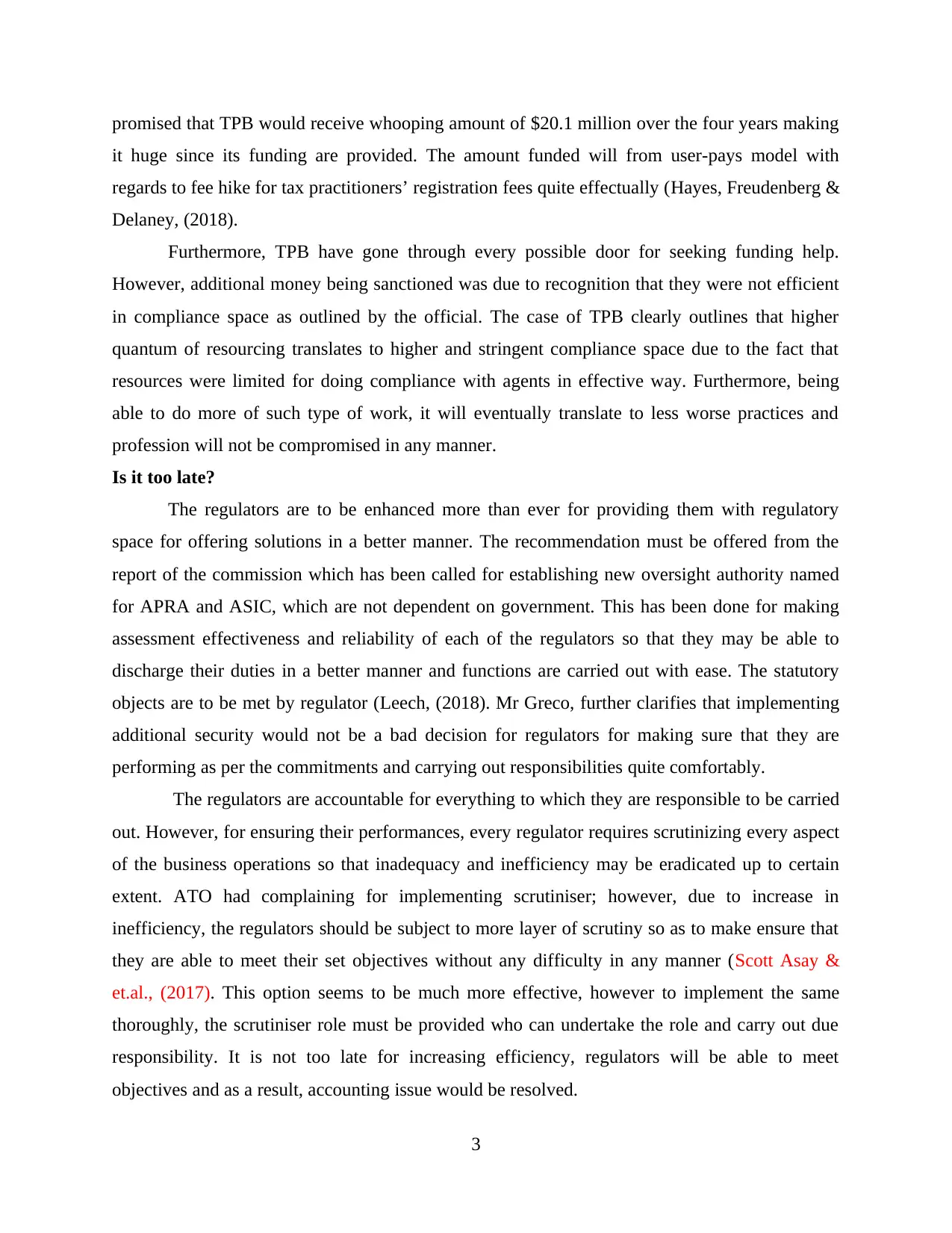
promised that TPB would receive whooping amount of $20.1 million over the four years making
it huge since its funding are provided. The amount funded will from user-pays model with
regards to fee hike for tax practitioners’ registration fees quite effectually (Hayes, Freudenberg &
Delaney, (2018).
Furthermore, TPB have gone through every possible door for seeking funding help.
However, additional money being sanctioned was due to recognition that they were not efficient
in compliance space as outlined by the official. The case of TPB clearly outlines that higher
quantum of resourcing translates to higher and stringent compliance space due to the fact that
resources were limited for doing compliance with agents in effective way. Furthermore, being
able to do more of such type of work, it will eventually translate to less worse practices and
profession will not be compromised in any manner.
Is it too late?
The regulators are to be enhanced more than ever for providing them with regulatory
space for offering solutions in a better manner. The recommendation must be offered from the
report of the commission which has been called for establishing new oversight authority named
for APRA and ASIC, which are not dependent on government. This has been done for making
assessment effectiveness and reliability of each of the regulators so that they may be able to
discharge their duties in a better manner and functions are carried out with ease. The statutory
objects are to be met by regulator (Leech, (2018). Mr Greco, further clarifies that implementing
additional security would not be a bad decision for regulators for making sure that they are
performing as per the commitments and carrying out responsibilities quite comfortably.
The regulators are accountable for everything to which they are responsible to be carried
out. However, for ensuring their performances, every regulator requires scrutinizing every aspect
of the business operations so that inadequacy and inefficiency may be eradicated up to certain
extent. ATO had complaining for implementing scrutiniser; however, due to increase in
inefficiency, the regulators should be subject to more layer of scrutiny so as to make ensure that
they are able to meet their set objectives without any difficulty in any manner (Scott Asay &
et.al., (2017). This option seems to be much more effective, however to implement the same
thoroughly, the scrutiniser role must be provided who can undertake the role and carry out due
responsibility. It is not too late for increasing efficiency, regulators will be able to meet
objectives and as a result, accounting issue would be resolved.
3
it huge since its funding are provided. The amount funded will from user-pays model with
regards to fee hike for tax practitioners’ registration fees quite effectually (Hayes, Freudenberg &
Delaney, (2018).
Furthermore, TPB have gone through every possible door for seeking funding help.
However, additional money being sanctioned was due to recognition that they were not efficient
in compliance space as outlined by the official. The case of TPB clearly outlines that higher
quantum of resourcing translates to higher and stringent compliance space due to the fact that
resources were limited for doing compliance with agents in effective way. Furthermore, being
able to do more of such type of work, it will eventually translate to less worse practices and
profession will not be compromised in any manner.
Is it too late?
The regulators are to be enhanced more than ever for providing them with regulatory
space for offering solutions in a better manner. The recommendation must be offered from the
report of the commission which has been called for establishing new oversight authority named
for APRA and ASIC, which are not dependent on government. This has been done for making
assessment effectiveness and reliability of each of the regulators so that they may be able to
discharge their duties in a better manner and functions are carried out with ease. The statutory
objects are to be met by regulator (Leech, (2018). Mr Greco, further clarifies that implementing
additional security would not be a bad decision for regulators for making sure that they are
performing as per the commitments and carrying out responsibilities quite comfortably.
The regulators are accountable for everything to which they are responsible to be carried
out. However, for ensuring their performances, every regulator requires scrutinizing every aspect
of the business operations so that inadequacy and inefficiency may be eradicated up to certain
extent. ATO had complaining for implementing scrutiniser; however, due to increase in
inefficiency, the regulators should be subject to more layer of scrutiny so as to make ensure that
they are able to meet their set objectives without any difficulty in any manner (Scott Asay &
et.al., (2017). This option seems to be much more effective, however to implement the same
thoroughly, the scrutiniser role must be provided who can undertake the role and carry out due
responsibility. It is not too late for increasing efficiency, regulators will be able to meet
objectives and as a result, accounting issue would be resolved.
3
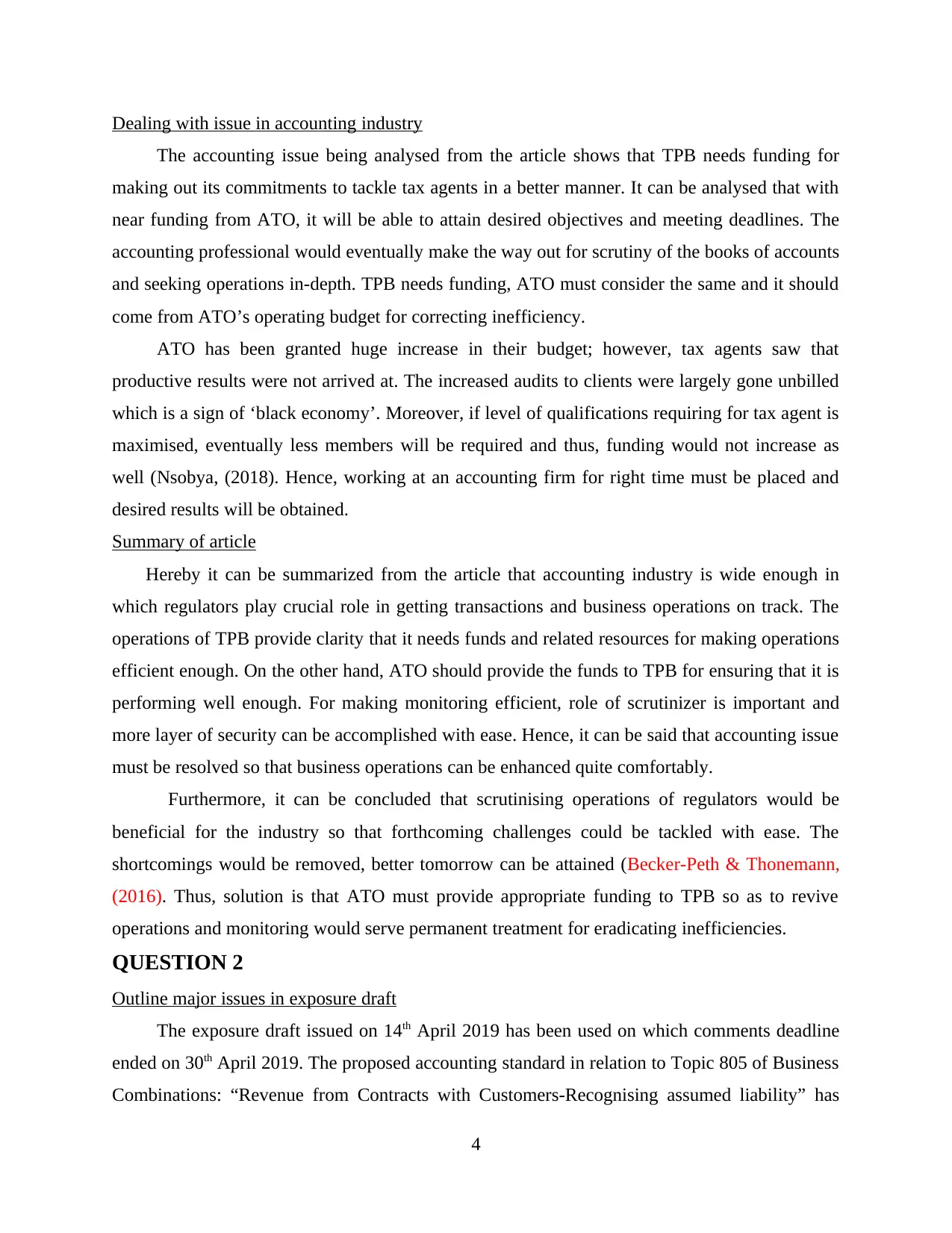
Dealing with issue in accounting industry
The accounting issue being analysed from the article shows that TPB needs funding for
making out its commitments to tackle tax agents in a better manner. It can be analysed that with
near funding from ATO, it will be able to attain desired objectives and meeting deadlines. The
accounting professional would eventually make the way out for scrutiny of the books of accounts
and seeking operations in-depth. TPB needs funding, ATO must consider the same and it should
come from ATO’s operating budget for correcting inefficiency.
ATO has been granted huge increase in their budget; however, tax agents saw that
productive results were not arrived at. The increased audits to clients were largely gone unbilled
which is a sign of ‘black economy’. Moreover, if level of qualifications requiring for tax agent is
maximised, eventually less members will be required and thus, funding would not increase as
well (Nsobya, (2018). Hence, working at an accounting firm for right time must be placed and
desired results will be obtained.
Summary of article
Hereby it can be summarized from the article that accounting industry is wide enough in
which regulators play crucial role in getting transactions and business operations on track. The
operations of TPB provide clarity that it needs funds and related resources for making operations
efficient enough. On the other hand, ATO should provide the funds to TPB for ensuring that it is
performing well enough. For making monitoring efficient, role of scrutinizer is important and
more layer of security can be accomplished with ease. Hence, it can be said that accounting issue
must be resolved so that business operations can be enhanced quite comfortably.
Furthermore, it can be concluded that scrutinising operations of regulators would be
beneficial for the industry so that forthcoming challenges could be tackled with ease. The
shortcomings would be removed, better tomorrow can be attained (Becker-Peth & Thonemann,
(2016). Thus, solution is that ATO must provide appropriate funding to TPB so as to revive
operations and monitoring would serve permanent treatment for eradicating inefficiencies.
QUESTION 2
Outline major issues in exposure draft
The exposure draft issued on 14th April 2019 has been used on which comments deadline
ended on 30th April 2019. The proposed accounting standard in relation to Topic 805 of Business
Combinations: “Revenue from Contracts with Customers-Recognising assumed liability” has
4
The accounting issue being analysed from the article shows that TPB needs funding for
making out its commitments to tackle tax agents in a better manner. It can be analysed that with
near funding from ATO, it will be able to attain desired objectives and meeting deadlines. The
accounting professional would eventually make the way out for scrutiny of the books of accounts
and seeking operations in-depth. TPB needs funding, ATO must consider the same and it should
come from ATO’s operating budget for correcting inefficiency.
ATO has been granted huge increase in their budget; however, tax agents saw that
productive results were not arrived at. The increased audits to clients were largely gone unbilled
which is a sign of ‘black economy’. Moreover, if level of qualifications requiring for tax agent is
maximised, eventually less members will be required and thus, funding would not increase as
well (Nsobya, (2018). Hence, working at an accounting firm for right time must be placed and
desired results will be obtained.
Summary of article
Hereby it can be summarized from the article that accounting industry is wide enough in
which regulators play crucial role in getting transactions and business operations on track. The
operations of TPB provide clarity that it needs funds and related resources for making operations
efficient enough. On the other hand, ATO should provide the funds to TPB for ensuring that it is
performing well enough. For making monitoring efficient, role of scrutinizer is important and
more layer of security can be accomplished with ease. Hence, it can be said that accounting issue
must be resolved so that business operations can be enhanced quite comfortably.
Furthermore, it can be concluded that scrutinising operations of regulators would be
beneficial for the industry so that forthcoming challenges could be tackled with ease. The
shortcomings would be removed, better tomorrow can be attained (Becker-Peth & Thonemann,
(2016). Thus, solution is that ATO must provide appropriate funding to TPB so as to revive
operations and monitoring would serve permanent treatment for eradicating inefficiencies.
QUESTION 2
Outline major issues in exposure draft
The exposure draft issued on 14th April 2019 has been used on which comments deadline
ended on 30th April 2019. The proposed accounting standard in relation to Topic 805 of Business
Combinations: “Revenue from Contracts with Customers-Recognising assumed liability” has
4
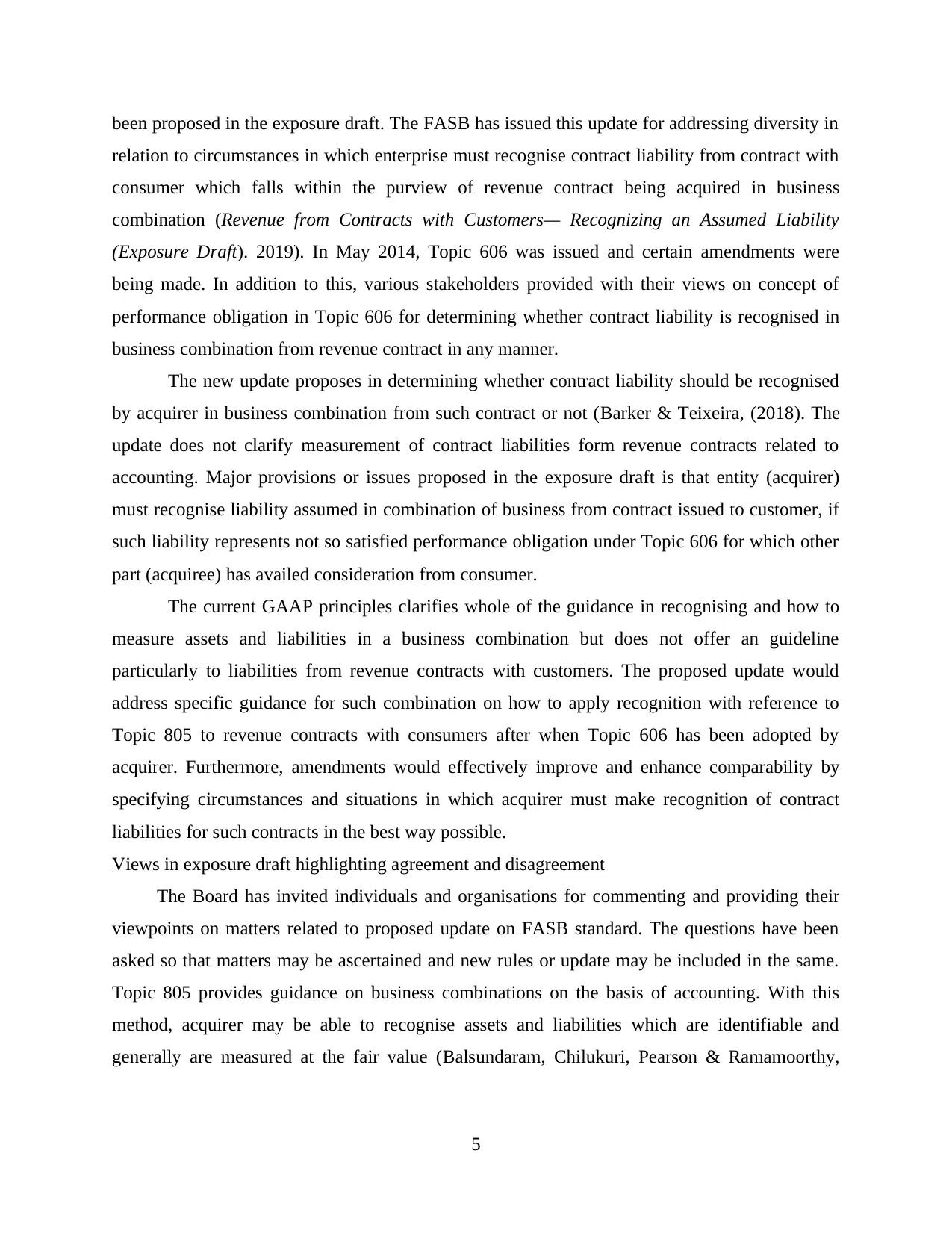
been proposed in the exposure draft. The FASB has issued this update for addressing diversity in
relation to circumstances in which enterprise must recognise contract liability from contract with
consumer which falls within the purview of revenue contract being acquired in business
combination (Revenue from Contracts with Customers— Recognizing an Assumed Liability
(Exposure Draft). 2019). In May 2014, Topic 606 was issued and certain amendments were
being made. In addition to this, various stakeholders provided with their views on concept of
performance obligation in Topic 606 for determining whether contract liability is recognised in
business combination from revenue contract in any manner.
The new update proposes in determining whether contract liability should be recognised
by acquirer in business combination from such contract or not (Barker & Teixeira, (2018). The
update does not clarify measurement of contract liabilities form revenue contracts related to
accounting. Major provisions or issues proposed in the exposure draft is that entity (acquirer)
must recognise liability assumed in combination of business from contract issued to customer, if
such liability represents not so satisfied performance obligation under Topic 606 for which other
part (acquiree) has availed consideration from consumer.
The current GAAP principles clarifies whole of the guidance in recognising and how to
measure assets and liabilities in a business combination but does not offer an guideline
particularly to liabilities from revenue contracts with customers. The proposed update would
address specific guidance for such combination on how to apply recognition with reference to
Topic 805 to revenue contracts with consumers after when Topic 606 has been adopted by
acquirer. Furthermore, amendments would effectively improve and enhance comparability by
specifying circumstances and situations in which acquirer must make recognition of contract
liabilities for such contracts in the best way possible.
Views in exposure draft highlighting agreement and disagreement
The Board has invited individuals and organisations for commenting and providing their
viewpoints on matters related to proposed update on FASB standard. The questions have been
asked so that matters may be ascertained and new rules or update may be included in the same.
Topic 805 provides guidance on business combinations on the basis of accounting. With this
method, acquirer may be able to recognise assets and liabilities which are identifiable and
generally are measured at the fair value (Balsundaram, Chilukuri, Pearson & Ramamoorthy,
5
relation to circumstances in which enterprise must recognise contract liability from contract with
consumer which falls within the purview of revenue contract being acquired in business
combination (Revenue from Contracts with Customers— Recognizing an Assumed Liability
(Exposure Draft). 2019). In May 2014, Topic 606 was issued and certain amendments were
being made. In addition to this, various stakeholders provided with their views on concept of
performance obligation in Topic 606 for determining whether contract liability is recognised in
business combination from revenue contract in any manner.
The new update proposes in determining whether contract liability should be recognised
by acquirer in business combination from such contract or not (Barker & Teixeira, (2018). The
update does not clarify measurement of contract liabilities form revenue contracts related to
accounting. Major provisions or issues proposed in the exposure draft is that entity (acquirer)
must recognise liability assumed in combination of business from contract issued to customer, if
such liability represents not so satisfied performance obligation under Topic 606 for which other
part (acquiree) has availed consideration from consumer.
The current GAAP principles clarifies whole of the guidance in recognising and how to
measure assets and liabilities in a business combination but does not offer an guideline
particularly to liabilities from revenue contracts with customers. The proposed update would
address specific guidance for such combination on how to apply recognition with reference to
Topic 805 to revenue contracts with consumers after when Topic 606 has been adopted by
acquirer. Furthermore, amendments would effectively improve and enhance comparability by
specifying circumstances and situations in which acquirer must make recognition of contract
liabilities for such contracts in the best way possible.
Views in exposure draft highlighting agreement and disagreement
The Board has invited individuals and organisations for commenting and providing their
viewpoints on matters related to proposed update on FASB standard. The questions have been
asked so that matters may be ascertained and new rules or update may be included in the same.
Topic 805 provides guidance on business combinations on the basis of accounting. With this
method, acquirer may be able to recognise assets and liabilities which are identifiable and
generally are measured at the fair value (Balsundaram, Chilukuri, Pearson & Ramamoorthy,
5
Paraphrase This Document
Need a fresh take? Get an instant paraphrase of this document with our AI Paraphraser
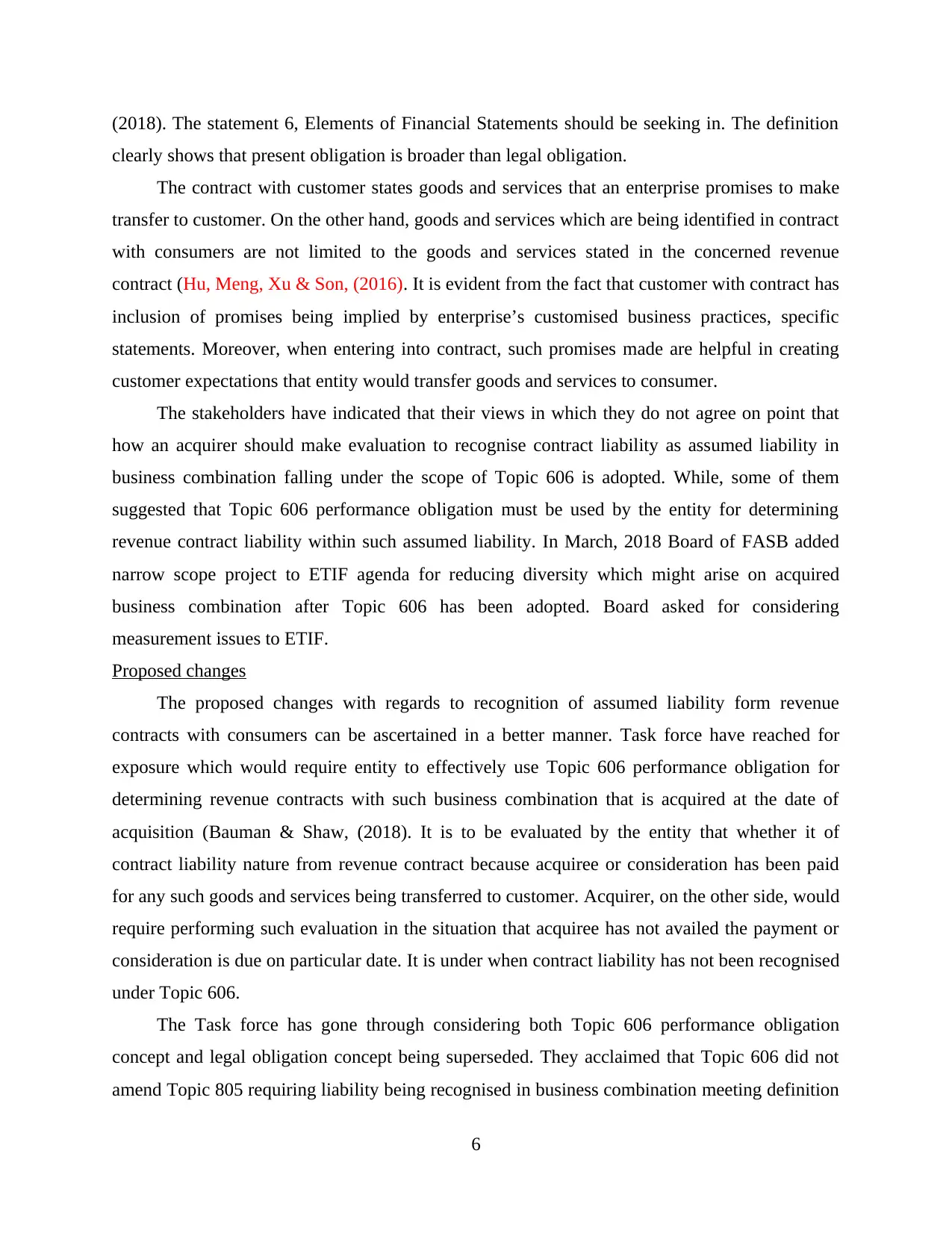
(2018). The statement 6, Elements of Financial Statements should be seeking in. The definition
clearly shows that present obligation is broader than legal obligation.
The contract with customer states goods and services that an enterprise promises to make
transfer to customer. On the other hand, goods and services which are being identified in contract
with consumers are not limited to the goods and services stated in the concerned revenue
contract (Hu, Meng, Xu & Son, (2016). It is evident from the fact that customer with contract has
inclusion of promises being implied by enterprise’s customised business practices, specific
statements. Moreover, when entering into contract, such promises made are helpful in creating
customer expectations that entity would transfer goods and services to consumer.
The stakeholders have indicated that their views in which they do not agree on point that
how an acquirer should make evaluation to recognise contract liability as assumed liability in
business combination falling under the scope of Topic 606 is adopted. While, some of them
suggested that Topic 606 performance obligation must be used by the entity for determining
revenue contract liability within such assumed liability. In March, 2018 Board of FASB added
narrow scope project to ETIF agenda for reducing diversity which might arise on acquired
business combination after Topic 606 has been adopted. Board asked for considering
measurement issues to ETIF.
Proposed changes
The proposed changes with regards to recognition of assumed liability form revenue
contracts with consumers can be ascertained in a better manner. Task force have reached for
exposure which would require entity to effectively use Topic 606 performance obligation for
determining revenue contracts with such business combination that is acquired at the date of
acquisition (Bauman & Shaw, (2018). It is to be evaluated by the entity that whether it of
contract liability nature from revenue contract because acquiree or consideration has been paid
for any such goods and services being transferred to customer. Acquirer, on the other side, would
require performing such evaluation in the situation that acquiree has not availed the payment or
consideration is due on particular date. It is under when contract liability has not been recognised
under Topic 606.
The Task force has gone through considering both Topic 606 performance obligation
concept and legal obligation concept being superseded. They acclaimed that Topic 606 did not
amend Topic 805 requiring liability being recognised in business combination meeting definition
6
clearly shows that present obligation is broader than legal obligation.
The contract with customer states goods and services that an enterprise promises to make
transfer to customer. On the other hand, goods and services which are being identified in contract
with consumers are not limited to the goods and services stated in the concerned revenue
contract (Hu, Meng, Xu & Son, (2016). It is evident from the fact that customer with contract has
inclusion of promises being implied by enterprise’s customised business practices, specific
statements. Moreover, when entering into contract, such promises made are helpful in creating
customer expectations that entity would transfer goods and services to consumer.
The stakeholders have indicated that their views in which they do not agree on point that
how an acquirer should make evaluation to recognise contract liability as assumed liability in
business combination falling under the scope of Topic 606 is adopted. While, some of them
suggested that Topic 606 performance obligation must be used by the entity for determining
revenue contract liability within such assumed liability. In March, 2018 Board of FASB added
narrow scope project to ETIF agenda for reducing diversity which might arise on acquired
business combination after Topic 606 has been adopted. Board asked for considering
measurement issues to ETIF.
Proposed changes
The proposed changes with regards to recognition of assumed liability form revenue
contracts with consumers can be ascertained in a better manner. Task force have reached for
exposure which would require entity to effectively use Topic 606 performance obligation for
determining revenue contracts with such business combination that is acquired at the date of
acquisition (Bauman & Shaw, (2018). It is to be evaluated by the entity that whether it of
contract liability nature from revenue contract because acquiree or consideration has been paid
for any such goods and services being transferred to customer. Acquirer, on the other side, would
require performing such evaluation in the situation that acquiree has not availed the payment or
consideration is due on particular date. It is under when contract liability has not been recognised
under Topic 606.
The Task force has gone through considering both Topic 606 performance obligation
concept and legal obligation concept being superseded. They acclaimed that Topic 606 did not
amend Topic 805 requiring liability being recognised in business combination meeting definition
6
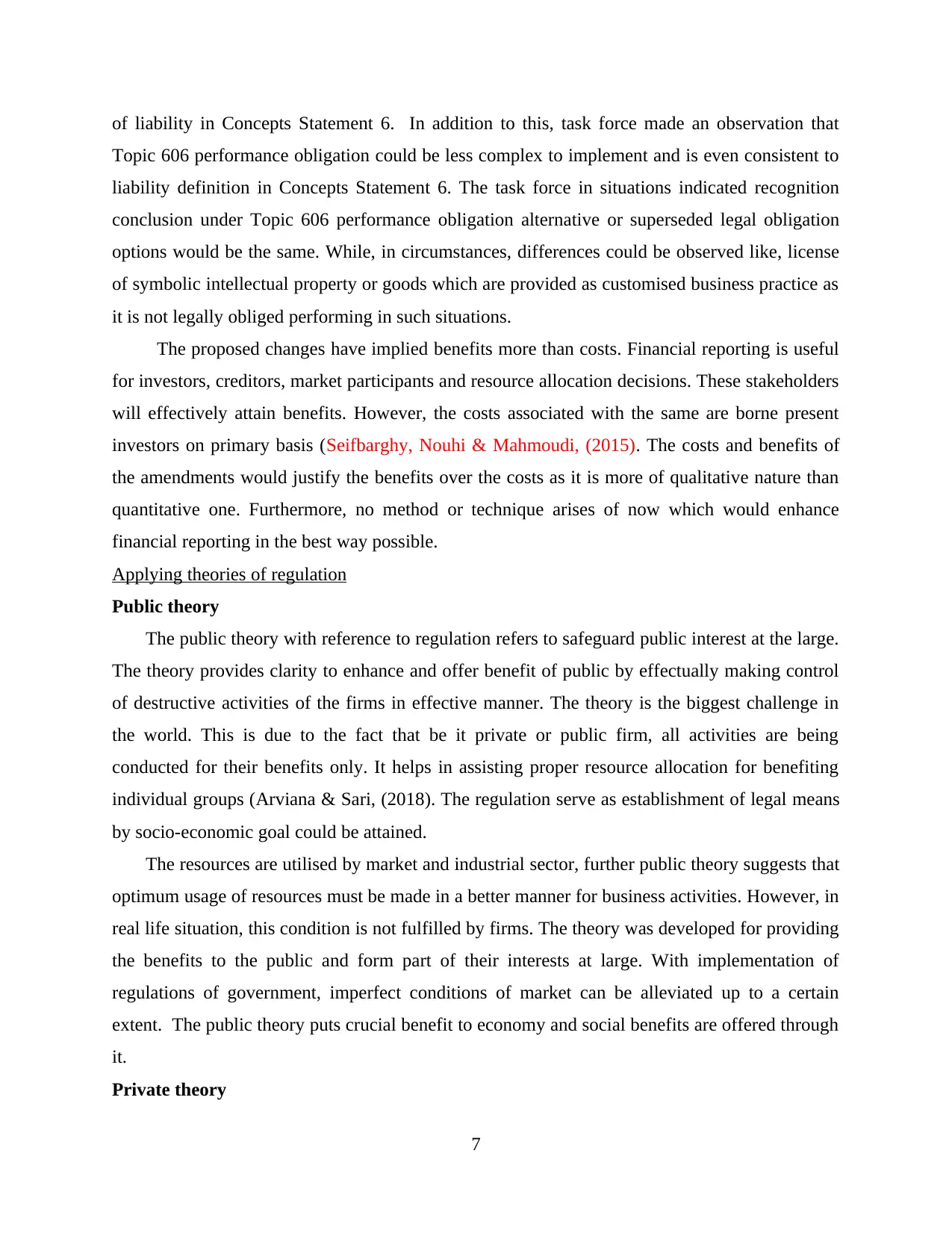
of liability in Concepts Statement 6. In addition to this, task force made an observation that
Topic 606 performance obligation could be less complex to implement and is even consistent to
liability definition in Concepts Statement 6. The task force in situations indicated recognition
conclusion under Topic 606 performance obligation alternative or superseded legal obligation
options would be the same. While, in circumstances, differences could be observed like, license
of symbolic intellectual property or goods which are provided as customised business practice as
it is not legally obliged performing in such situations.
The proposed changes have implied benefits more than costs. Financial reporting is useful
for investors, creditors, market participants and resource allocation decisions. These stakeholders
will effectively attain benefits. However, the costs associated with the same are borne present
investors on primary basis (Seifbarghy, Nouhi & Mahmoudi, (2015). The costs and benefits of
the amendments would justify the benefits over the costs as it is more of qualitative nature than
quantitative one. Furthermore, no method or technique arises of now which would enhance
financial reporting in the best way possible.
Applying theories of regulation
Public theory
The public theory with reference to regulation refers to safeguard public interest at the large.
The theory provides clarity to enhance and offer benefit of public by effectually making control
of destructive activities of the firms in effective manner. The theory is the biggest challenge in
the world. This is due to the fact that be it private or public firm, all activities are being
conducted for their benefits only. It helps in assisting proper resource allocation for benefiting
individual groups (Arviana & Sari, (2018). The regulation serve as establishment of legal means
by socio-economic goal could be attained.
The resources are utilised by market and industrial sector, further public theory suggests that
optimum usage of resources must be made in a better manner for business activities. However, in
real life situation, this condition is not fulfilled by firms. The theory was developed for providing
the benefits to the public and form part of their interests at large. With implementation of
regulations of government, imperfect conditions of market can be alleviated up to a certain
extent. The public theory puts crucial benefit to economy and social benefits are offered through
it.
Private theory
7
Topic 606 performance obligation could be less complex to implement and is even consistent to
liability definition in Concepts Statement 6. The task force in situations indicated recognition
conclusion under Topic 606 performance obligation alternative or superseded legal obligation
options would be the same. While, in circumstances, differences could be observed like, license
of symbolic intellectual property or goods which are provided as customised business practice as
it is not legally obliged performing in such situations.
The proposed changes have implied benefits more than costs. Financial reporting is useful
for investors, creditors, market participants and resource allocation decisions. These stakeholders
will effectively attain benefits. However, the costs associated with the same are borne present
investors on primary basis (Seifbarghy, Nouhi & Mahmoudi, (2015). The costs and benefits of
the amendments would justify the benefits over the costs as it is more of qualitative nature than
quantitative one. Furthermore, no method or technique arises of now which would enhance
financial reporting in the best way possible.
Applying theories of regulation
Public theory
The public theory with reference to regulation refers to safeguard public interest at the large.
The theory provides clarity to enhance and offer benefit of public by effectually making control
of destructive activities of the firms in effective manner. The theory is the biggest challenge in
the world. This is due to the fact that be it private or public firm, all activities are being
conducted for their benefits only. It helps in assisting proper resource allocation for benefiting
individual groups (Arviana & Sari, (2018). The regulation serve as establishment of legal means
by socio-economic goal could be attained.
The resources are utilised by market and industrial sector, further public theory suggests that
optimum usage of resources must be made in a better manner for business activities. However, in
real life situation, this condition is not fulfilled by firms. The theory was developed for providing
the benefits to the public and form part of their interests at large. With implementation of
regulations of government, imperfect conditions of market can be alleviated up to a certain
extent. The public theory puts crucial benefit to economy and social benefits are offered through
it.
Private theory
7
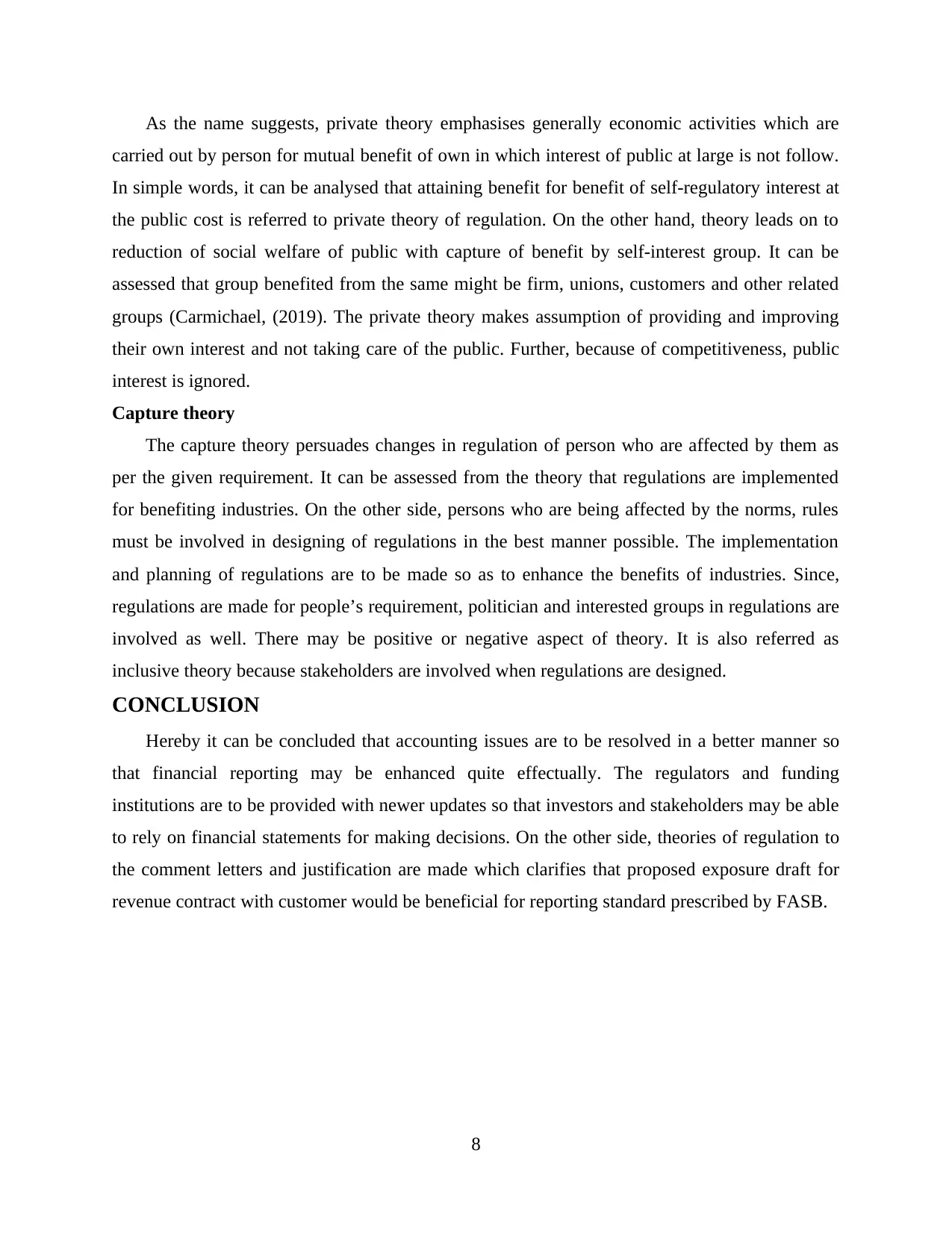
As the name suggests, private theory emphasises generally economic activities which are
carried out by person for mutual benefit of own in which interest of public at large is not follow.
In simple words, it can be analysed that attaining benefit for benefit of self-regulatory interest at
the public cost is referred to private theory of regulation. On the other hand, theory leads on to
reduction of social welfare of public with capture of benefit by self-interest group. It can be
assessed that group benefited from the same might be firm, unions, customers and other related
groups (Carmichael, (2019). The private theory makes assumption of providing and improving
their own interest and not taking care of the public. Further, because of competitiveness, public
interest is ignored.
Capture theory
The capture theory persuades changes in regulation of person who are affected by them as
per the given requirement. It can be assessed from the theory that regulations are implemented
for benefiting industries. On the other side, persons who are being affected by the norms, rules
must be involved in designing of regulations in the best manner possible. The implementation
and planning of regulations are to be made so as to enhance the benefits of industries. Since,
regulations are made for people’s requirement, politician and interested groups in regulations are
involved as well. There may be positive or negative aspect of theory. It is also referred as
inclusive theory because stakeholders are involved when regulations are designed.
CONCLUSION
Hereby it can be concluded that accounting issues are to be resolved in a better manner so
that financial reporting may be enhanced quite effectually. The regulators and funding
institutions are to be provided with newer updates so that investors and stakeholders may be able
to rely on financial statements for making decisions. On the other side, theories of regulation to
the comment letters and justification are made which clarifies that proposed exposure draft for
revenue contract with customer would be beneficial for reporting standard prescribed by FASB.
8
carried out by person for mutual benefit of own in which interest of public at large is not follow.
In simple words, it can be analysed that attaining benefit for benefit of self-regulatory interest at
the public cost is referred to private theory of regulation. On the other hand, theory leads on to
reduction of social welfare of public with capture of benefit by self-interest group. It can be
assessed that group benefited from the same might be firm, unions, customers and other related
groups (Carmichael, (2019). The private theory makes assumption of providing and improving
their own interest and not taking care of the public. Further, because of competitiveness, public
interest is ignored.
Capture theory
The capture theory persuades changes in regulation of person who are affected by them as
per the given requirement. It can be assessed from the theory that regulations are implemented
for benefiting industries. On the other side, persons who are being affected by the norms, rules
must be involved in designing of regulations in the best manner possible. The implementation
and planning of regulations are to be made so as to enhance the benefits of industries. Since,
regulations are made for people’s requirement, politician and interested groups in regulations are
involved as well. There may be positive or negative aspect of theory. It is also referred as
inclusive theory because stakeholders are involved when regulations are designed.
CONCLUSION
Hereby it can be concluded that accounting issues are to be resolved in a better manner so
that financial reporting may be enhanced quite effectually. The regulators and funding
institutions are to be provided with newer updates so that investors and stakeholders may be able
to rely on financial statements for making decisions. On the other side, theories of regulation to
the comment letters and justification are made which clarifies that proposed exposure draft for
revenue contract with customer would be beneficial for reporting standard prescribed by FASB.
8
Secure Best Marks with AI Grader
Need help grading? Try our AI Grader for instant feedback on your assignments.
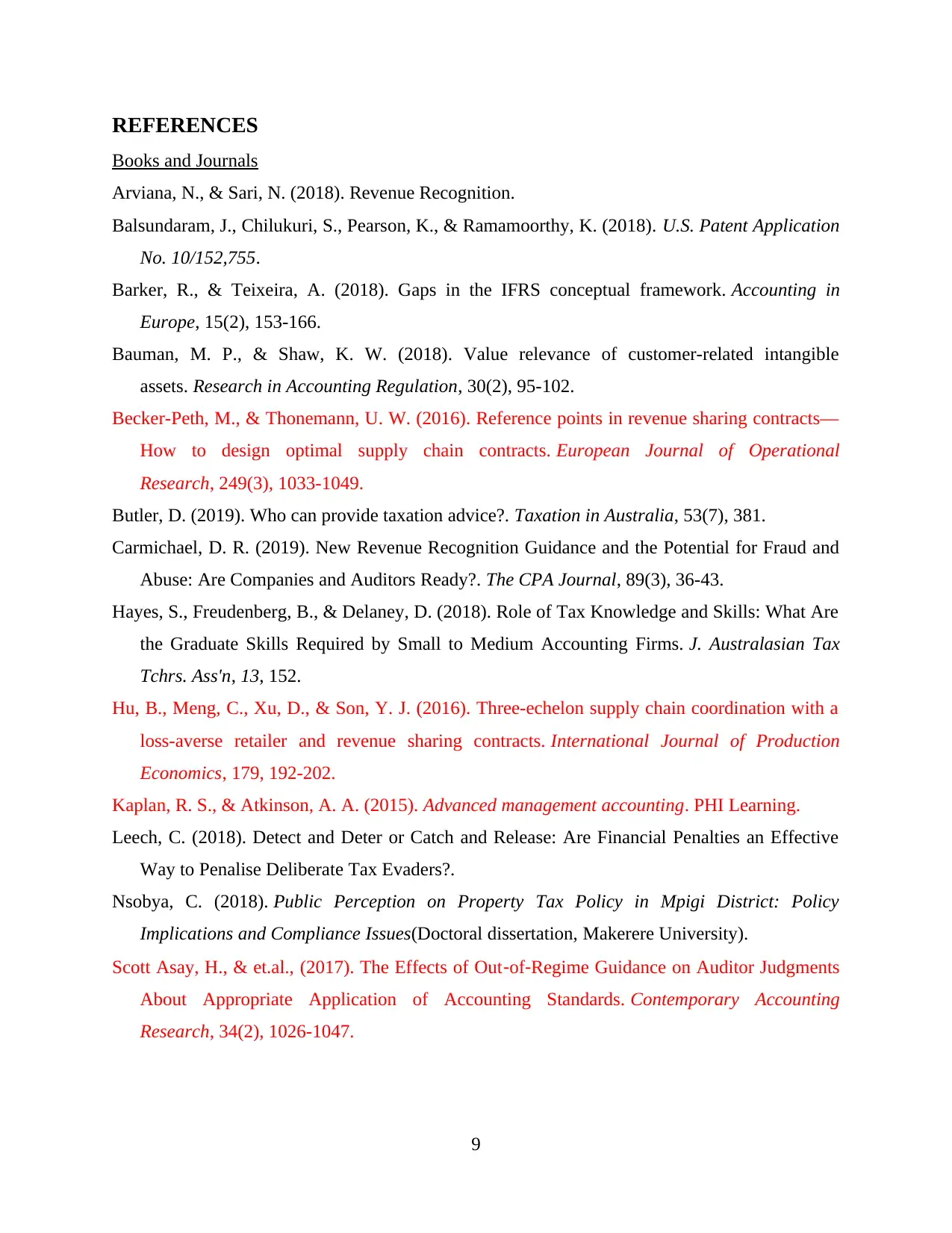
REFERENCES
Books and Journals
Arviana, N., & Sari, N. (2018). Revenue Recognition.
Balsundaram, J., Chilukuri, S., Pearson, K., & Ramamoorthy, K. (2018). U.S. Patent Application
No. 10/152,755.
Barker, R., & Teixeira, A. (2018). Gaps in the IFRS conceptual framework. Accounting in
Europe, 15(2), 153-166.
Bauman, M. P., & Shaw, K. W. (2018). Value relevance of customer-related intangible
assets. Research in Accounting Regulation, 30(2), 95-102.
Becker-Peth, M., & Thonemann, U. W. (2016). Reference points in revenue sharing contracts—
How to design optimal supply chain contracts. European Journal of Operational
Research, 249(3), 1033-1049.
Butler, D. (2019). Who can provide taxation advice?. Taxation in Australia, 53(7), 381.
Carmichael, D. R. (2019). New Revenue Recognition Guidance and the Potential for Fraud and
Abuse: Are Companies and Auditors Ready?. The CPA Journal, 89(3), 36-43.
Hayes, S., Freudenberg, B., & Delaney, D. (2018). Role of Tax Knowledge and Skills: What Are
the Graduate Skills Required by Small to Medium Accounting Firms. J. Australasian Tax
Tchrs. Ass'n, 13, 152.
Hu, B., Meng, C., Xu, D., & Son, Y. J. (2016). Three-echelon supply chain coordination with a
loss-averse retailer and revenue sharing contracts. International Journal of Production
Economics, 179, 192-202.
Kaplan, R. S., & Atkinson, A. A. (2015). Advanced management accounting. PHI Learning.
Leech, C. (2018). Detect and Deter or Catch and Release: Are Financial Penalties an Effective
Way to Penalise Deliberate Tax Evaders?.
Nsobya, C. (2018). Public Perception on Property Tax Policy in Mpigi District: Policy
Implications and Compliance Issues(Doctoral dissertation, Makerere University).
Scott Asay, H., & et.al., (2017). The Effects of Out‐of‐Regime Guidance on Auditor Judgments
About Appropriate Application of Accounting Standards. Contemporary Accounting
Research, 34(2), 1026-1047.
9
Books and Journals
Arviana, N., & Sari, N. (2018). Revenue Recognition.
Balsundaram, J., Chilukuri, S., Pearson, K., & Ramamoorthy, K. (2018). U.S. Patent Application
No. 10/152,755.
Barker, R., & Teixeira, A. (2018). Gaps in the IFRS conceptual framework. Accounting in
Europe, 15(2), 153-166.
Bauman, M. P., & Shaw, K. W. (2018). Value relevance of customer-related intangible
assets. Research in Accounting Regulation, 30(2), 95-102.
Becker-Peth, M., & Thonemann, U. W. (2016). Reference points in revenue sharing contracts—
How to design optimal supply chain contracts. European Journal of Operational
Research, 249(3), 1033-1049.
Butler, D. (2019). Who can provide taxation advice?. Taxation in Australia, 53(7), 381.
Carmichael, D. R. (2019). New Revenue Recognition Guidance and the Potential for Fraud and
Abuse: Are Companies and Auditors Ready?. The CPA Journal, 89(3), 36-43.
Hayes, S., Freudenberg, B., & Delaney, D. (2018). Role of Tax Knowledge and Skills: What Are
the Graduate Skills Required by Small to Medium Accounting Firms. J. Australasian Tax
Tchrs. Ass'n, 13, 152.
Hu, B., Meng, C., Xu, D., & Son, Y. J. (2016). Three-echelon supply chain coordination with a
loss-averse retailer and revenue sharing contracts. International Journal of Production
Economics, 179, 192-202.
Kaplan, R. S., & Atkinson, A. A. (2015). Advanced management accounting. PHI Learning.
Leech, C. (2018). Detect and Deter or Catch and Release: Are Financial Penalties an Effective
Way to Penalise Deliberate Tax Evaders?.
Nsobya, C. (2018). Public Perception on Property Tax Policy in Mpigi District: Policy
Implications and Compliance Issues(Doctoral dissertation, Makerere University).
Scott Asay, H., & et.al., (2017). The Effects of Out‐of‐Regime Guidance on Auditor Judgments
About Appropriate Application of Accounting Standards. Contemporary Accounting
Research, 34(2), 1026-1047.
9
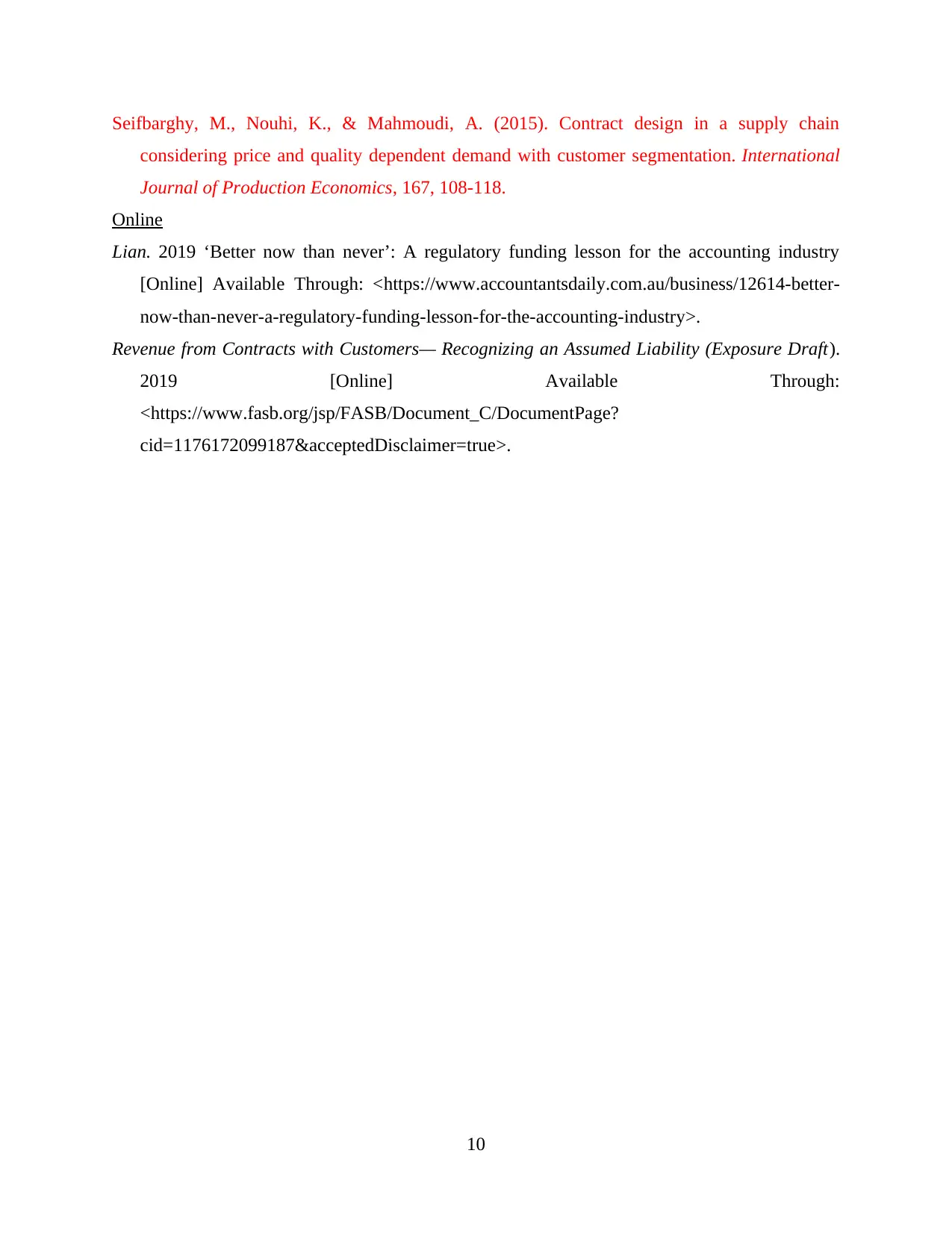
Seifbarghy, M., Nouhi, K., & Mahmoudi, A. (2015). Contract design in a supply chain
considering price and quality dependent demand with customer segmentation. International
Journal of Production Economics, 167, 108-118.
Online
Lian. 2019 ‘Better now than never’: A regulatory funding lesson for the accounting industry
[Online] Available Through: <https://www.accountantsdaily.com.au/business/12614-better-
now-than-never-a-regulatory-funding-lesson-for-the-accounting-industry>.
Revenue from Contracts with Customers— Recognizing an Assumed Liability (Exposure Draft).
2019 [Online] Available Through:
<https://www.fasb.org/jsp/FASB/Document_C/DocumentPage?
cid=1176172099187&acceptedDisclaimer=true>.
10
considering price and quality dependent demand with customer segmentation. International
Journal of Production Economics, 167, 108-118.
Online
Lian. 2019 ‘Better now than never’: A regulatory funding lesson for the accounting industry
[Online] Available Through: <https://www.accountantsdaily.com.au/business/12614-better-
now-than-never-a-regulatory-funding-lesson-for-the-accounting-industry>.
Revenue from Contracts with Customers— Recognizing an Assumed Liability (Exposure Draft).
2019 [Online] Available Through:
<https://www.fasb.org/jsp/FASB/Document_C/DocumentPage?
cid=1176172099187&acceptedDisclaimer=true>.
10
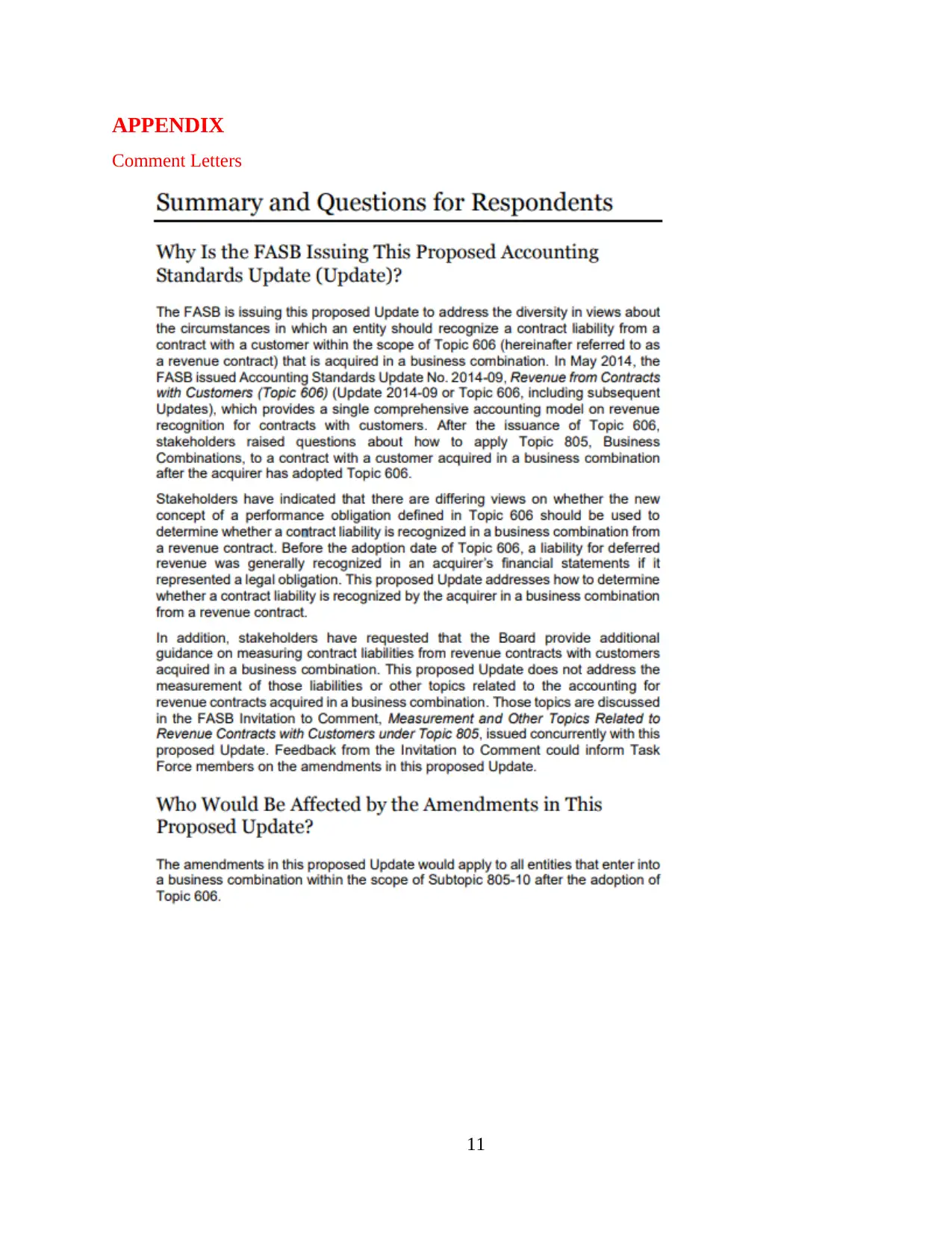
APPENDIX
Comment Letters
11
Comment Letters
11
Paraphrase This Document
Need a fresh take? Get an instant paraphrase of this document with our AI Paraphraser
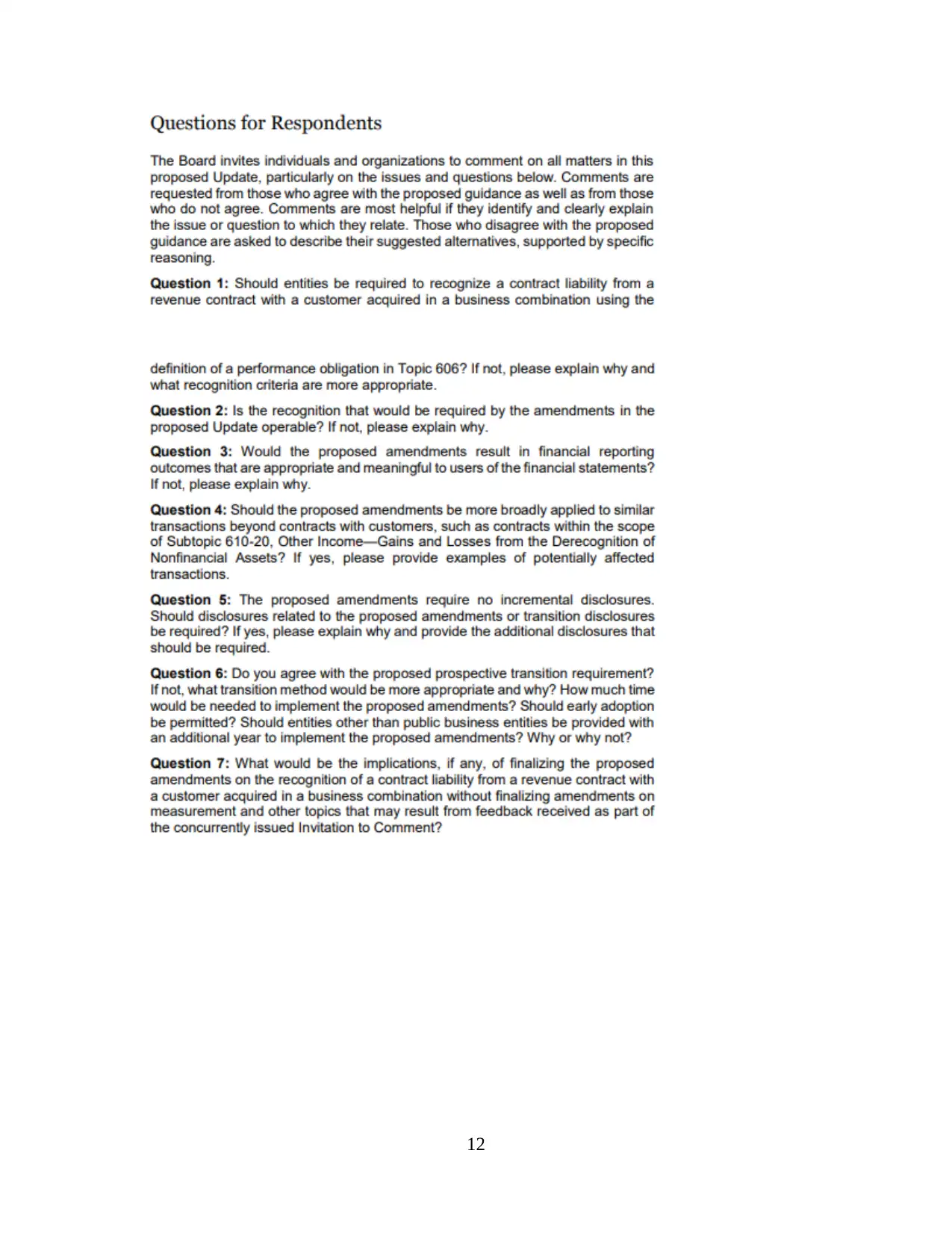
12
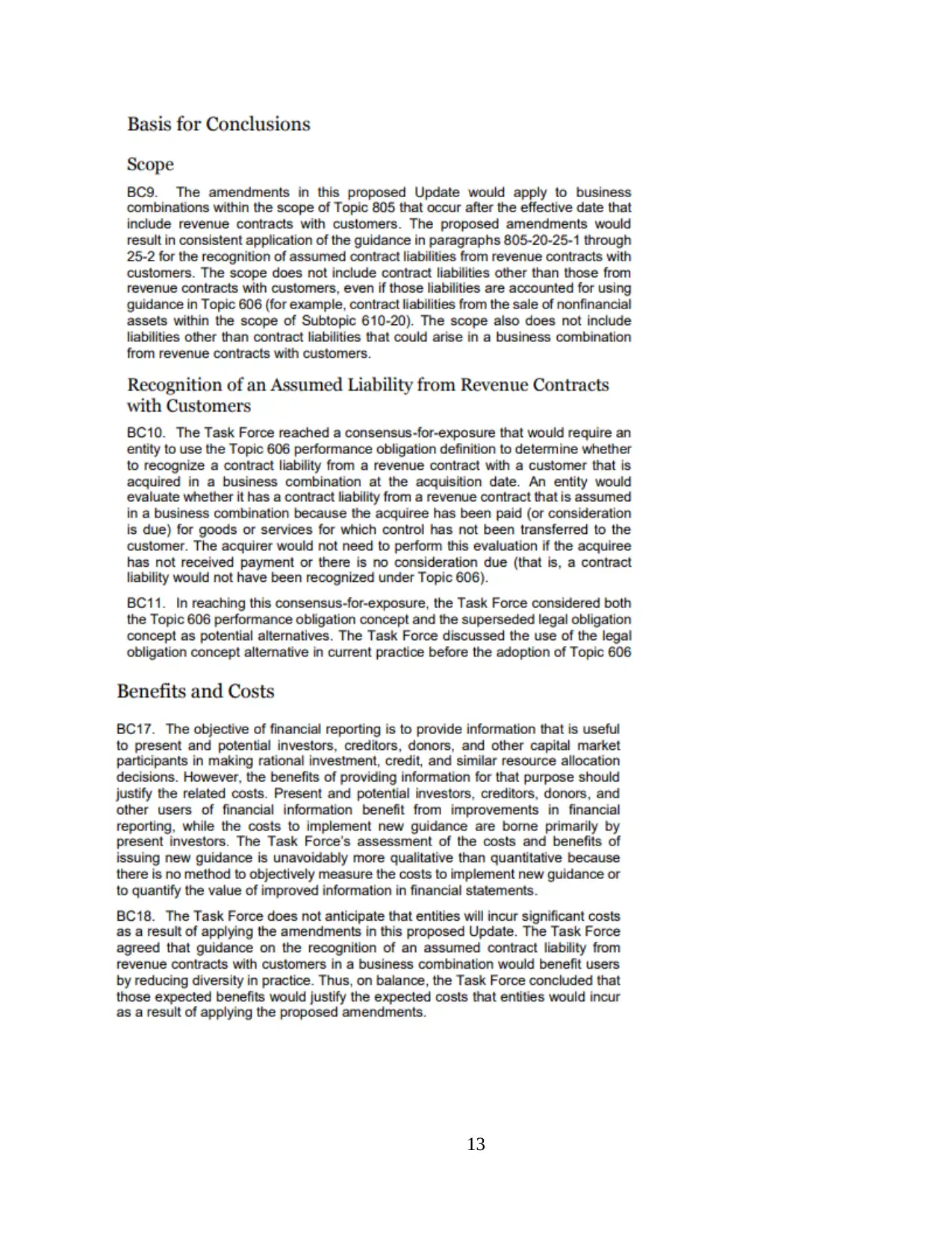
13
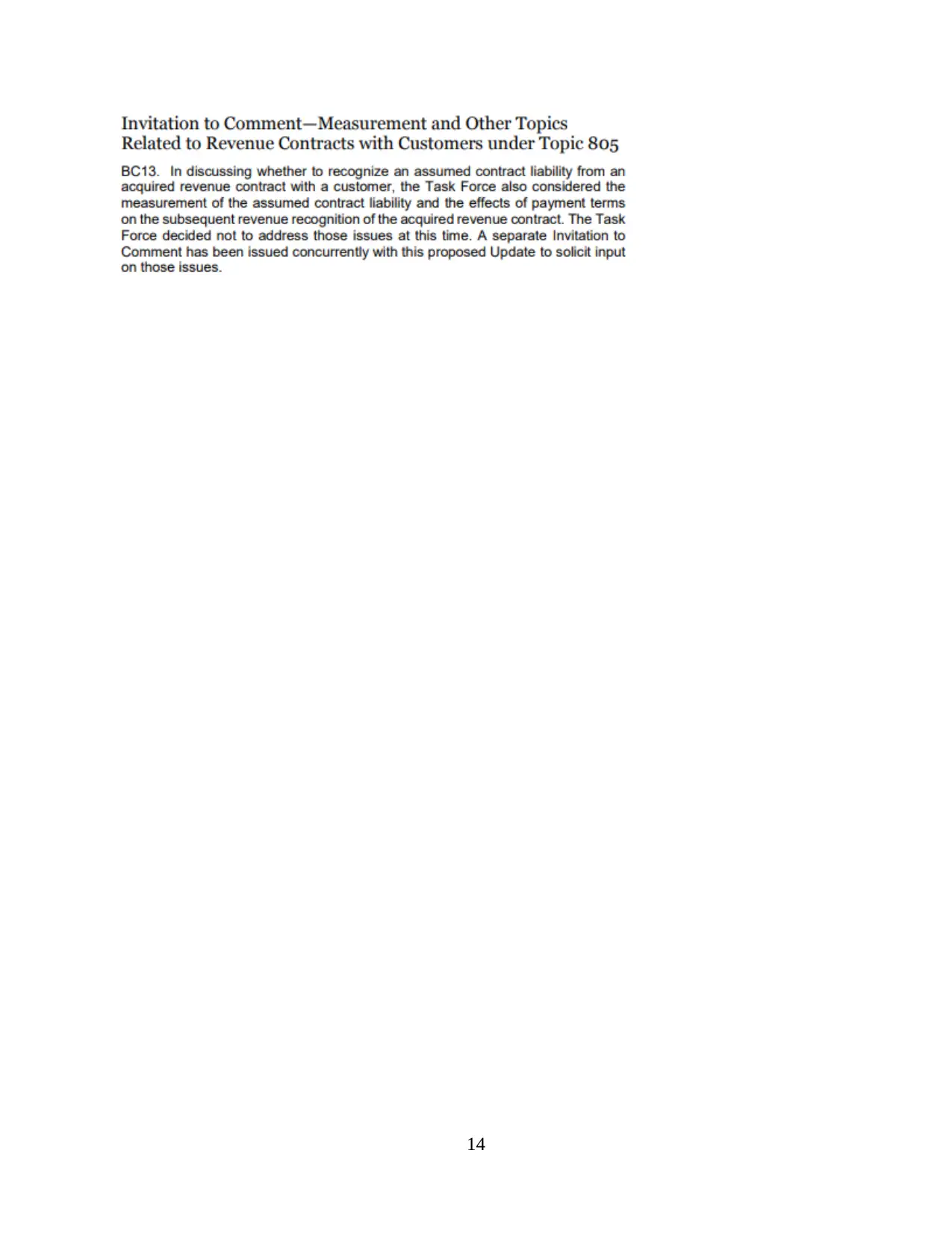
14
1 out of 16
Related Documents
Your All-in-One AI-Powered Toolkit for Academic Success.
+13062052269
info@desklib.com
Available 24*7 on WhatsApp / Email
![[object Object]](/_next/static/media/star-bottom.7253800d.svg)
Unlock your academic potential
© 2024 | Zucol Services PVT LTD | All rights reserved.





